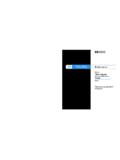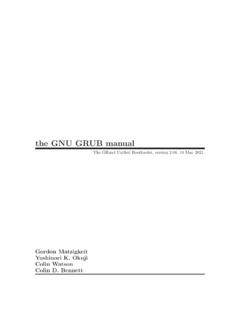Transcription of How to Use the IEEEtran LaTeX Class
1 JOURNAL OF LaTeX Class FILES, VOL. 14, NO. 8, AUGUST 20151 How to Use the IEEE tran LaTeX ClassMichael Shell,Member, IEEE(Invited Paper)Abstract This article describes how to use the IEEE tran classwith LaTeX to produce high quality typeset papers that are suit-able for submission to the Institute of Electrical and ElectronicsEngineers (IEEE). IEEE tran can produce conference, journaland technical note (correspondence) papers with a suitable choiceof Class options. This document was produced using IEEE tranin journal Terms Class , IEEE tran, LaTeX , paper, style, template, INTRODUCTIONWITH a recent IEEE tran Class file, a computer runningLATEX, and a basic understanding of the LaTeX language,an author can produce professional quality typeset researchpapers very quickly, inexpensively.
2 And with minimal purpose of this article is to serve as a user guide ofIEEE tran LaTeX Class and to document its unique features document applies to version and later of versions do not have all of the features described will display the version number on the user s consolewhen a document using it is being compiled. The latest versionof IEEE tran and its support files can be obtained from IEEE sweb site [1], or CTAN [2]. This latter site may have someadditional material, such as beta test versions and files relatedto non-IEEE uses of IEEE tran. See the IEEE tran homepage[3] for frequently asked questions and recent news to this document are the , , , , , which are bare bones example (tem-plate) files of a conference, journal, IEEE CommunicationsSociety journal, IEEE Computer Society conference, IEEEC omputer Society journal and IEEE TRANSACTIONS ONMAGNETICS paper, respectively.
3 Authors can quickly obtaina functional document by using these files as starters for theirown work. A more advanced example featuring the use ofManuscript created February 25, 2002; revised August 26, 2015. This workwas supported by the IEEE. This work is distributed under the LaTeX ProjectPublic License (LPPL) ( ) version A copyof the LPPL, version , is included in the base LaTeX documentation of alldistributions of LaTeX released 2003/12/01 or later. The opinions expressedhere are entirely that of the author. No warranty is expressed or implied. Userassumes all for current contact that it is the convention of this document not to hyphenate commandor file names and to display them intypewriter font .
4 Within suchconstructs, spaces are not implied at a line break and will be explicitly carriedinto the beginning of the next line. This behavior is not a feature of IEEE tran,but is used here to illustrate computer commands packages along with more complex usage techniques,can be found is assumed that the reader has at least a basic workingknowledge of LaTeX . Those so lacking are strongly encouragedto read some of the excellent literature on the subject [4] [6].In particular, Tobias Oetiker sThe Not So Short Introductionto LaTeX 2 [5], which provides a general overview of workingwith LaTeX , and Stefan M.
5 Moser sHow to Typeset Equationsin LaTeX [6], which focuses on the formatting of IEEE-styleequations using IEEE tran s IEEE eqnarray commands, are bothavailable for free support for LaTeX related questions can be obtainedin the internet newsgroup There is also asearchable list of frequently asked questions about LaTeX [7].Please note that the appendices sections contain informationon installing the IEEE tran Class file as well as tips on how toavoid commonly made CLASSOPTIONST here are a number of Class options that can be used tocontrol the overall mode and behavior of IEEE tran.
6 These arespecified in the traditional LaTeX way. For example,\documentclass[9pt,technote]{IEE E tran}is used with correspondence/brief/technote papers. The variouscategories of options will now be discussed. For each category,the default option is shown in bold. The user must specify anoption from each category in which the default is not the onedesired. The various categories are totally orthogonal to eachother changes in one will not affect the defaults in the 9pt,10pt, 11pt, 12ptThere are four possible values for the normal text size. 10ptis used by the vast majority of papers. Notable exceptions aretechnote papers, which use 9pt text and the initial submissionsto some conferences that use aware that IEEE Computer Society publications use PostScript ( , big point , bp) point sizes ( , 72bp =1in) rather than the traditional typesetters point ( , 1in).
7 Also, 10pt IEEE Computer Society journal papersactually use a slightly smaller, , font size (probably tocompensate for the slightly wider nature of the Palatino font ).IEEE tran will automatically tweak the selected font size asneeded depending on the 0000/00$ 2015 Michael Shell2 JOURNAL OF LaTeX Class FILES, VOL. 14, NO. 8, AUGUST 2015B. draft, draftcls, draftclsnofoot,finalIEEE tran provides for three draft modes as well as thenormal final mode. The draft modes provide a larger (double)line spacing to allow for editing comments as well as oneinch margins on all four sides of the paper.
8 The standard draftoption putseverypackage used in the document into draftmode. With most graphics packages, this has the effect ofdisabling the rendering of figures. If this is not desired, onecan use the draftcls option instead to yield a draft mode thatwill be confined within the IEEE tran Class so that figures willbe included as normal. draftclsnofoot is like draftcls, but doesnot display the word DRAFT along with the date at thefoot of each page. Both draft and draftclsnofoot modes implydraftcls (which is a subset of the other two). When using oneof the draft modes, most users will also want to select theonecolumn conference,journal, technote, peerreview, peerreviewcaIEEE tran offers five major modes to encompass conference,journal, correspondence (brief/technote) and peer review pa-pers.
9 Journal and technote modes will produce papers verysimilar to those that appear in many IEEE TRANSACTIONS journals. When using technote, most users should also selectthe 9pt option. The peerreview mode is much like the journalmode, but produces a single-column cover page (with thetitle, author names and abstract) to facilitate anonymous peerreview. The title is repeated (without the author names orabstract) on the first page after the cover usingthe peer review options require an\IEEE peerreviewmaketitlecommand (in addition to and after the traditional\maketitle) to be executed at the place the cover page is to end usually just after the abstract.
10 This command will be silentlyignored with the non-peerreview modes. See the bare templatefiles for an example of the placement of this command. Thepeerreviewca mode is like peerreview, but allows the authorname information to be entered and formatted as is donein conference mode (see Section IV-B2 for details) so thatauthor affiliation and contact information is more visible tothe ) Conference Mode Details:Conference mode makes anumber of significant changes to the way IEEE tran behaves: The margins are increased as the height of the text isreduced to about In particular, the bottom marginwill become larger than that of the top as the IEEE wantsextra clearance at the bottom.

